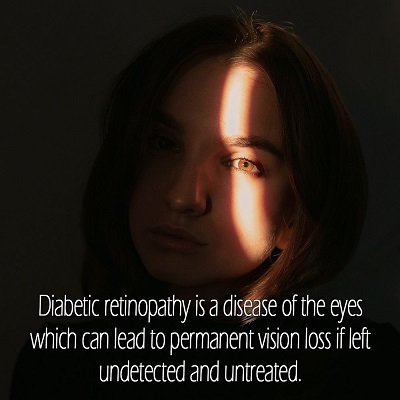 As if having diabetes wasn’t complicated enough, it’s also imperative to consider some of the serious complications which could arise with uncontrolled blood sugars.
As if having diabetes wasn’t complicated enough, it’s also imperative to consider some of the serious complications which could arise with uncontrolled blood sugars.
Diabetic retinopathy is a disease of the eyes which can lead to permanent vision loss if left undetected and untreated.
What Exactly IS Diabetic Retinopathy?
The light-sensitive, thin layer of tissue at the back wall of your eye is called the retina. When light enters the eye, the retina sends the signal to the brain by way of the optic nerve. The brain then tells you what you’re actually seeing; visual recognition.
In diabetic retinopathy, the tiny blood vessels of the retina become leaky and sometimes even deteriorate. Fluid gets into and under the retina from a leaky blood vessel.
This can also lead to macular edema which ends up causing blurry vision. When the blood vessels deteriorate, the retina tries to form new vessels, but they don’t get fully developed and end up being weak and leaky as well.
The scar tissue that’s formed from weakened blood vessels can also create extra pressure on the retina, causing retinal detachment. It can also lay the ground work for glaucoma and other serious eye issues which could result in blindness.
Diabetic retinopathy is the most common cause of vision problems and blindness in working-age adults in the United States.
From 2010 to 2050, the number of Americans with diabetic retinopathy is expected to double, from 7.7 million to 14.6 million, according to the Centers for Disease Control article Watch Out for Diabetic Retinopathy.
How Do You Know if You Have Diabetic Retinopathy?
You might not even have any symptoms in the early stages, which is why it’s critical to get annual comprehensive eye examinations, especially so for those with diabetes. Many eye care professionals dilate the pupils, which is how they test for diabetic retinopathy and other eye health conditions, even for those without known diabetes.
This is a good thing if you are diagnosed with diabetic retinopathy because it’s likely the disease is in the early stages and you can start treatment before you actually notice symptoms.
If the disease has progressed, those with more advanced stages might experience:
- Floaters or spots in the field of vision
- Halos surrounding lights
- Blurry vision
- Loss of central vision
- Loss of color vision.
Everyone with diabetes, type 1 or 2, can develop diabetic retinopathy. The longer you’ve had diabetes, the greater the risk for developing diabetic retinopathy, particularly if you’ve had problems controlling your sugar levels.
Also, keep in mind, pregnant women can develop gestational diabetes thus are also at risk for diabetic retinopathy, though the likelihood is much less than someone who has had long-term diabetes.
How Can You Help Prevent Diabetic Retinopathy?
First and foremost, good control of your diabetes is the imperative. Not only to decrease the chances of diabetic retinopathy, but also the many other complications which can arise from diabetes.
Cigarette smoking has been known to increase diabetic complications, so if you’re a smoker it would behoove you to start a smoking cessation program.
Also, make sure to keep regular appointments with your eye doctor and request testing for diabetic retinopathy if it’s not already part of their comprehensive examination.
Finally, if you do notice vision changes, don’t wait until your next yearly examination with your eye care professional. Go ahead and get that checked out right away. It’s better to be safe than sorry.
What Treatments are Available?
If you’ve been diagnosed with diabetic retinopathy, there are several treatments available that your eye care professional may recommend, and they all depend on the severity of your particular case.
- Medical Control – Getting control of your diabetes is the first step. You may need dietary changes or alterations to your diabetic medication regimen. Your doctor will also take into consideration how well your blood pressure is controlled. Your blood pressure has a direct effect on eye blood vessel health.
- Medications – There are a few medications available for treatment, including steroids, which are given by injection. Your eye care professional will determine how many and how often the injections should be administered.
- Surgery – Laser surgery is indicated if your eye care professional deems the blood vessels need to be sealed off to prevent leakage. It can also reduce retinal swelling, and oftentimes more than one treatment is necessary. Vitrectomy, another type of procedure, could be indicated for more advanced cases.
The best approach for those who think they may already have or could develop diabetic retinopathy is to not panic and take the necessary precautions sooner rather than later.






